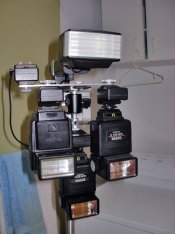If you test any flash unit against any other, with all of them in some sort of auto mode, it would be a sign of a bad flash if it didn't produce the same output as any other unit.
Who do you think I am, Gomer Pyle?

Attached is the patented SuperFlash™ arrangement that I was testing. The main purpose of the test was to see if the wireless triggers I'd just purchased work (they do!), and also to see how much juice this thing could kick out in combination, with and without an umbrella (to see what kind of options I can get with 4x5 portrait set-ups). Since it was necessary to fire each flash individually as well, I took readings then too.
All four flashes were set to full manual power, and were metered with a Quantum Calcu-Flash II from about four feet away. I didn't take notes, but I think it was about f16 at 100 iso for each flash. The Canon and the two Sunpaks are all rated at GN 100 (feet), while the Metz is 120.
Now, I'm sure someone will ask about the diffuser on the Metz. Removing it didn't seem to make any difference. However, this whole thing made me curious, so I just stood the Metz next to one of the Sunpaks and the meter a measured four feet away. The readings are the same as I remember (actually f18), but it looks like removing the diffuser is now consistently giving an extra 2/3rds of a stop extra light compared to the Sunpak (so, f22).
Therefore, it looks like they perform against each other like they should after all, but that both underperform compared to their stated ratings by almost exactly one stop (calculator tells me they should have been f25 and f30), meaning my Metz rates at an actual GN of 88, and the Sunpak a GN of 72.
So I'm not sure if that accounts for everything, but it looks like I might be Gomer Pyle after all.




